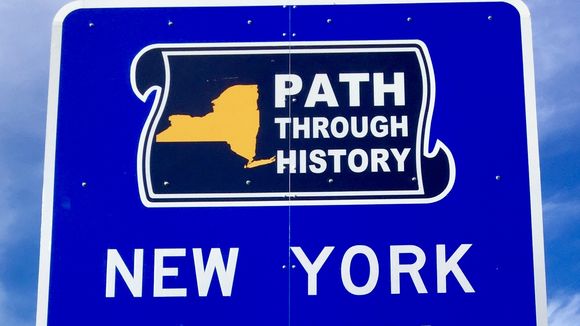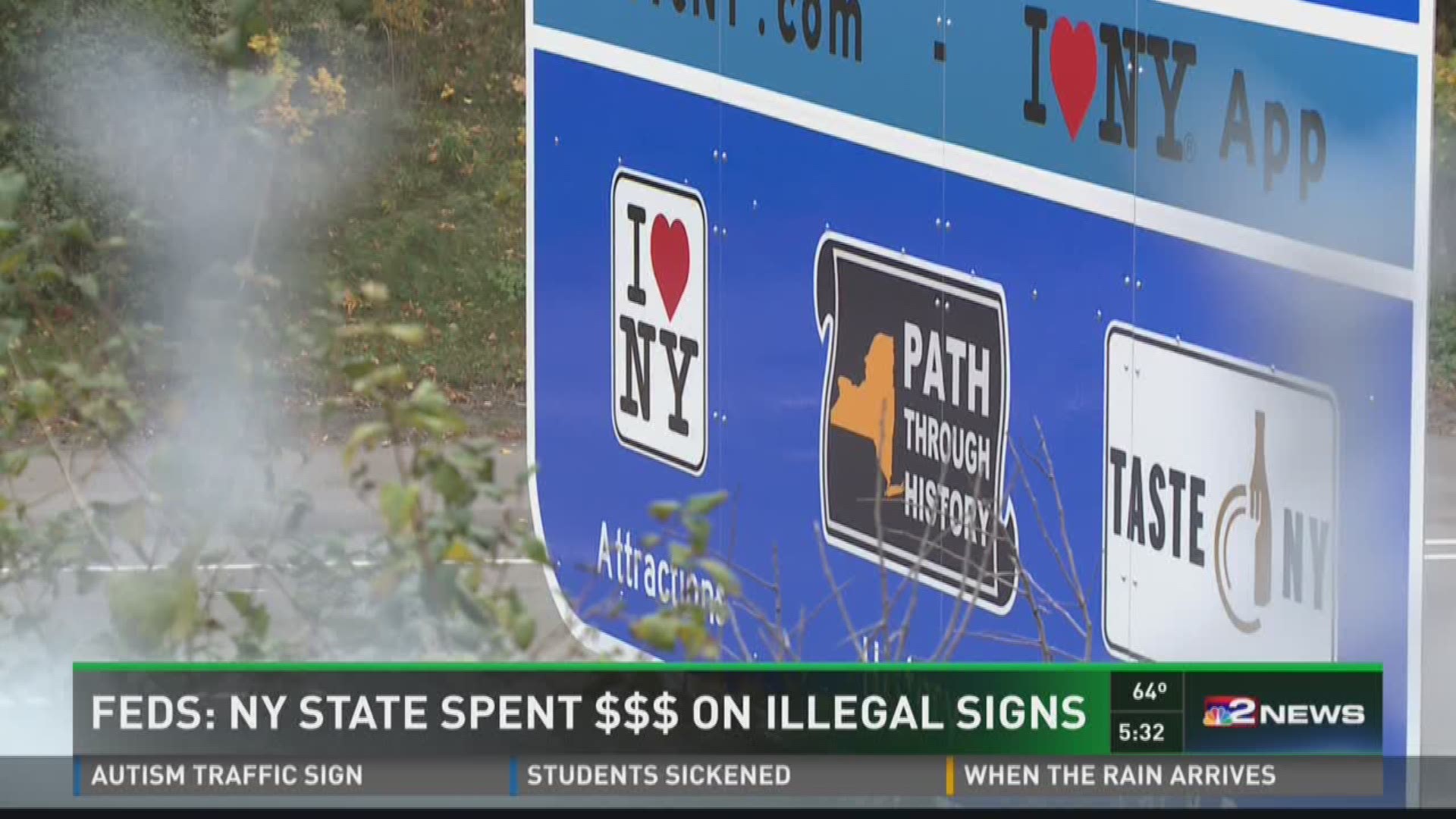ALBANY - Gov. Andrew Cuomo's administration dotted New York with 514 highway signs touting its tourism programs despite a federal ruling explicitly prohibiting the state from doing so.
Documents obtained by the USA Today Network's Albany Bureau show the Federal Highway Administration has repeatedly notified Cuomo's administration over the past three years that the signs violate federal and state law, which contain strict rules for what can and cannot be displayed on major roadways.
But the state Department of Transportation and Thruway Authority appear to have ignored the warnings, rapidly expanding the signage across the state while federal officials continued to voice concerns.
"It is our responsibility to ensure safety and compliance with (federal traffic sign rules) and therefore cannot condone the use of non-compliant signs on the federal-aid system in the state of New York," Randy Warden, a team leader for the highway administration, wrote to the state DOT in April 2014.
On Wednesday, the federal agency reaffirmed its position.
"Some of the signs have non-conforming symbols, while others violate sign lettering and other standards," highway administration spokesman Neil Gaffney said in a statement.
"Simple signs make for safer journeys. That means using signs that are easy to identify, comprehend and understand in a matter of seconds as you are driving.”
The state DOT disagrees, contending the signs follow "standard specifications" and are in "full compliance with federal law."
Long-running dispute
The long-running dispute centers on a series of blue highway signs along major roadways across New York, including the state Thruway and near entry points such as airports and ferries.
Often grouped in five, the signs are generally posted in rapid succession, a few hundred feet apart.
First comes a "motherboard" sign welcoming drivers to the state or touting the "New York State Experience," depending on its location. Then comes multiple signs promoting different state tourism programs, such as Taste NY, I Love NY and Path Through History.
Each of the signs also include a mention of ILoveNY.com and the state's I Love NY mobile app.
The documents obtained by the Albany Bureau show the state DOT penned a formal request to the Federal Highway Administration on May 31, 2013, asking to experiment with the new type of highway signs boosting the state's tourism programs.
Mark Kehrli, director of the federal Office of Transportation Operations, issued an official ruling to the state two weeks later: "Your request is hereby denied."
The logos and graphics proposed by the state amounted to "promotional advertising," Kehrli wrote in the letter dated June 13, 2013.
The type of branding sought by the state, he wrote, is prohibited by the federal Manual on Uniform Traffic Control Devices for Streets and Highways, or MUTCD, a dense set of rules that lays out uniform standards for highway signs across the country.

The state, however, seemed undeterred.
Six months later, Cuomo announced the new signage in his 2014 State of the State address.
He promised motorists would see the signs "literally in the next few days."
"We are going to launch a whole new signage campaign on our roads promoting the assets of New York, organized into three campaigns: The Path Through History campaign, the I Love New York attraction campaign and the Taste NY food and beverages," he said on Jan. 9, 2014.
As promised, the signs soon began popping up near the state's borders.
That prompted Warden, the highway administration team leader, to pen another letter to the state DOT on April 3, 2014. He wrote the signs violate the federal manual and the state vehicle-and-traffic law.
Warden asked what gives the state the authority to post the signs, requesting it devise a plan to remove signs that do not comply with federal rules.
The letter also asked the state to assure the federal agency that they will stop erecting them in the future.
In response, a state DOT official told the federal agency feels that signs are in compliance with the federal manual and state guidelines.
"The sign designs and spacing seek to impress simple but memorable information for later recall without posing a distraction," Todd Westhuis, acting director of the state DOT's Office of Traffic Safety and Mobility, wrote to the FHWA on May 14, 2014.
Ongoing battle
The dispute hasn't stopped there.
Since this past July, the state DOT and Thruway Authority have aggressively expanded the number of signs across the state, bringing the current total to 514, according to the DOT.
A list provided by the state shows the signs are most often placed near major highway exits or state attractions, such as on I-490 in Rochester, near the Tappan Zee Bridge in the Lower Hudson Valley and outside the Greater Binghamton International Airport in the Southern Tier.
In a statement this week, state DOT spokesman Gary Holmes contended the signs fully comply with the law.
The cost of the signs and posts -- not including the labor to install them -- was $1.76 million between the DOT and the Thruway Authority, according to the DOT.
"We view them as a critical element in a coordinated strategic program to promote the state’s multi-billion dollar tourism industry," Holmes said. "We continue to work with FHWA to ensure any questions are answered.”
In September, the behind-the-scenes battle briefly spilled into public view when a federal transportation safety engineer gave a presentation to a town highway superintendents' conference in Lake Placid.
The Federal Highway Administration engineer, Emmett McDevitt, singled out the New York tourism signs for violating state and federal law, according to a copy of his slideshow presentation obtained by the Albany Bureau.
"Many (of the) governor's proposed signing initiatives violate (the federal manual) standards and basic principles," one slide read.
The slide featured a photo of Cuomo with an imaginary thought bubble that read: "We will grow the economy with signing."
On Wednesday, Cuomo defended the signs, saying they work in conjunction with the state's aggressive efforts to market upstate through ads and online promotion.
He pointed out the state has an app that allows visitors to track what attractions are near them.
"We’re trying to capture those people who travel through New York and say, ‘See something while you’re here. Spend some of your money while you’re in upstate New York,'" Cuomo told reporters in Rochester.
Local pushback
In a few cases, the signs have received pushback from local leaders.
In Suffolk County on Long Island, municipal officials and local lawmakers heavily criticized the signs when they popped up this past summer in Montauk, Port Jefferson and Orient Point.
Amid the public outcry, the state DOT and local officials reached an agreement to significantly scale back the signs. In Montauk, a single sign was left, for example.
Mike Elmendorf, president and CEO of the state Associated General Contractors, said there has been a "fair amount of chatter" within his industry about the signs.
He questioned the need for the major expansion and the amount of money spent on them.
"I think the concern is you have an additional expense coming out of the capital budget for what is, if anything, an informational and maybe economic-development initiative," Elmendorf said.
"And on top of that, you now have the question of legality raised by the federal government. It sort of has a lot of folks scratching their head."
In a statement, a spokesman for Empire State Development -- the entity overseeing the state's tourism programs -- defended the sign program.
The state's tourism industry had an economic impact of $102 billion last year, according to ESD. The state spends about $50 million a year to promote tourism and development.
"The goal of the I Love NY road signs are to promote the state’s world-renowned destinations and attractions, to both residents and visitors, to encourage travel in New York state and support tourism in every region," said Jason Conwall, the ESD spokesman.
"We've put up similar signs in the past as part of this state's multi-pronged efforts to boost tourism -- and it's paid off."

